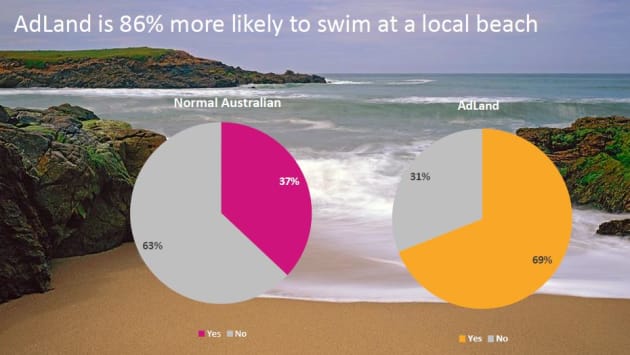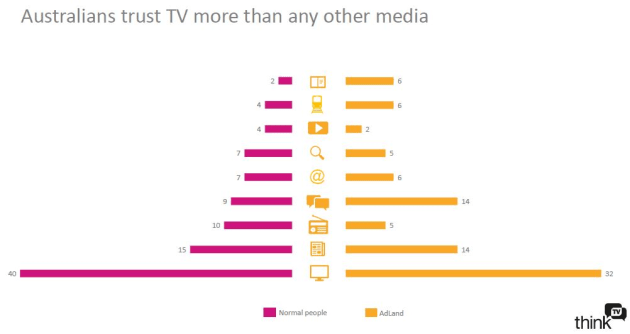
People working in adland significantly overestimate the use, credibility and recall of social media platforms for advertising, a new ThinkTV study has found.
The AdNation study, funded by the TV industry body and carried out by Dr Karen Nelson-Field, surveyed 1,636 adland professionals and 1,016 ordinary Australians to gauge their perceptions about different media channels as a platform for advertising.
It found adland professionals – made up of marketers, media buyers, creatives and trade press – have a much greater bias towards social media platforms and out of home than traditional media channels like TV, radio and print.
The study also revealed adland is riddled with projection bias towards social media channels.
More than a third of adland professionals (36%) prefer social media as a place to find the ads they liked – 16 percentage points higher than ordinary Australian (20%). This doesn't include YouTube ads, which adland underestimates.
Adland also underestimated the number of people that prefer TV as a channel for ads (22%) compared to ordinary people (42%).
Industry professionals also overestimate the popularity of out of home advertising compared to ordinary people. The study found that 10% of ad land professionals think Australians like outdoor ads when only 4% said they did.
Adland professionals are 22% more likely to have used Facebook in the past seven days, 43% more likely to have used YouTube and 96% more likely to have used Snapchat.
This lifts to 140% for Instagram, 161% for Netflix, 180% for ABCiView, 238% for Twitter, 285% for WhatsApp and 314% for Buzzfeed.
'Surprising findings'
Nelson-Field said she was surprised by the findings. "Even as someone who operates in media circles I was surprised at the level of disconnect between the media group and the reality of normal Australians," she added. "AdNation is a very important piece of work because it really identifies where the conversation needs to change.”
ThinkTV CEO Kim Portrate said the AdNation study "pops this bubble" of the media, marketing and advertising world.
“But it also makes a serious point. Knowing what people like, feel and do is critical to our success when it comes to growing brands. But we also know that our own preferences can lead to projection bias, which ultimately impacts on the spending decisions we make about media," she added.
“AdNation 2017’s findings represent a big opportunity for marketers and advertisers to reassess how in touch we are with the reality of everyday Australians. We need to keep their actual media consumption habits front of mind rather than simply using ourselves or our friends as a sample of one or a few."
The average adlander
The study also attempted to paint an image of how the average adland professional differs from the rest of the population.
Compared with the average Australian, adland professionals are younger, less likely to have children, nearly three times more likely to have a gym membership and more than twice as likely to be single and live in a share house.
They are more time-poor and work twice as many hours at the expense of TV, radio, time with family and pets.
Adland professionals are twice as likely to have taken a swim at a local beach in the last three months, seven times more likely to shop at a local farmers’ market, and five times more likely to shop at a local independent grocer.
Ordinary Australians are 38% more likely to have fly screens and twice as likely to have a lawn mower.
The study also found that 91% of adland journalists swim at a local beach, a statistic that clearly doesn't apply to this newsroom, where the figure is closer to 20%. However, the 36% of journalists shopping at Aldi is probably not too far from the truth.
Such studies that tries to find a distinct averages should be taken cautiously, particularly when the average age of adland skews young. However, it does reinforce some of the digital bias within the industry that some older professionals in the industry recognise.
Further findings
Have something to say on this? Share your views in the comments section below. Or if you have a news story or tip-off, drop us a line at adnews@yaffa.com.au
Sign up to the AdNews newsletter, like us on Facebook or follow us on Twitter for breaking stories and campaigns throughout the day.









